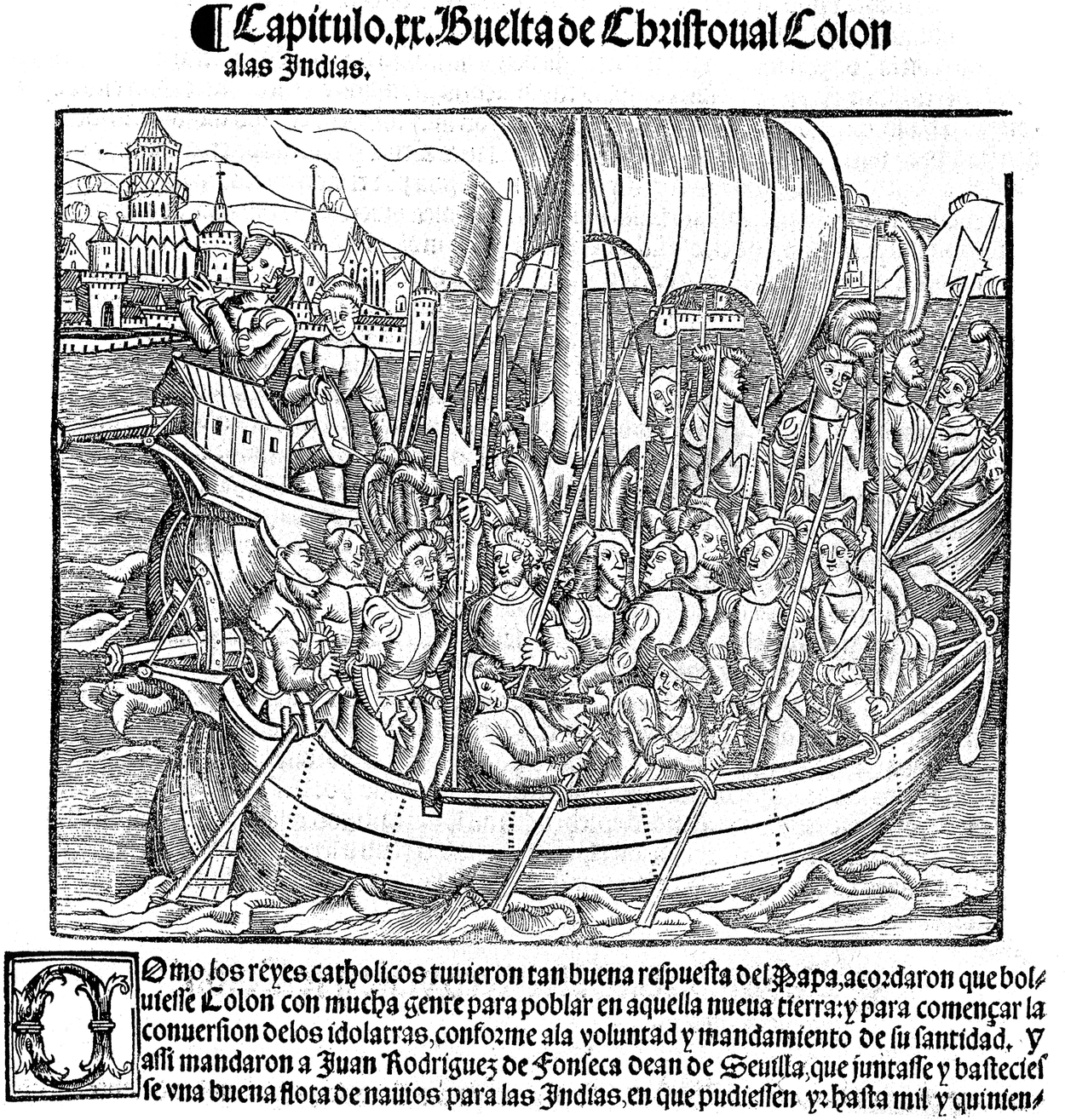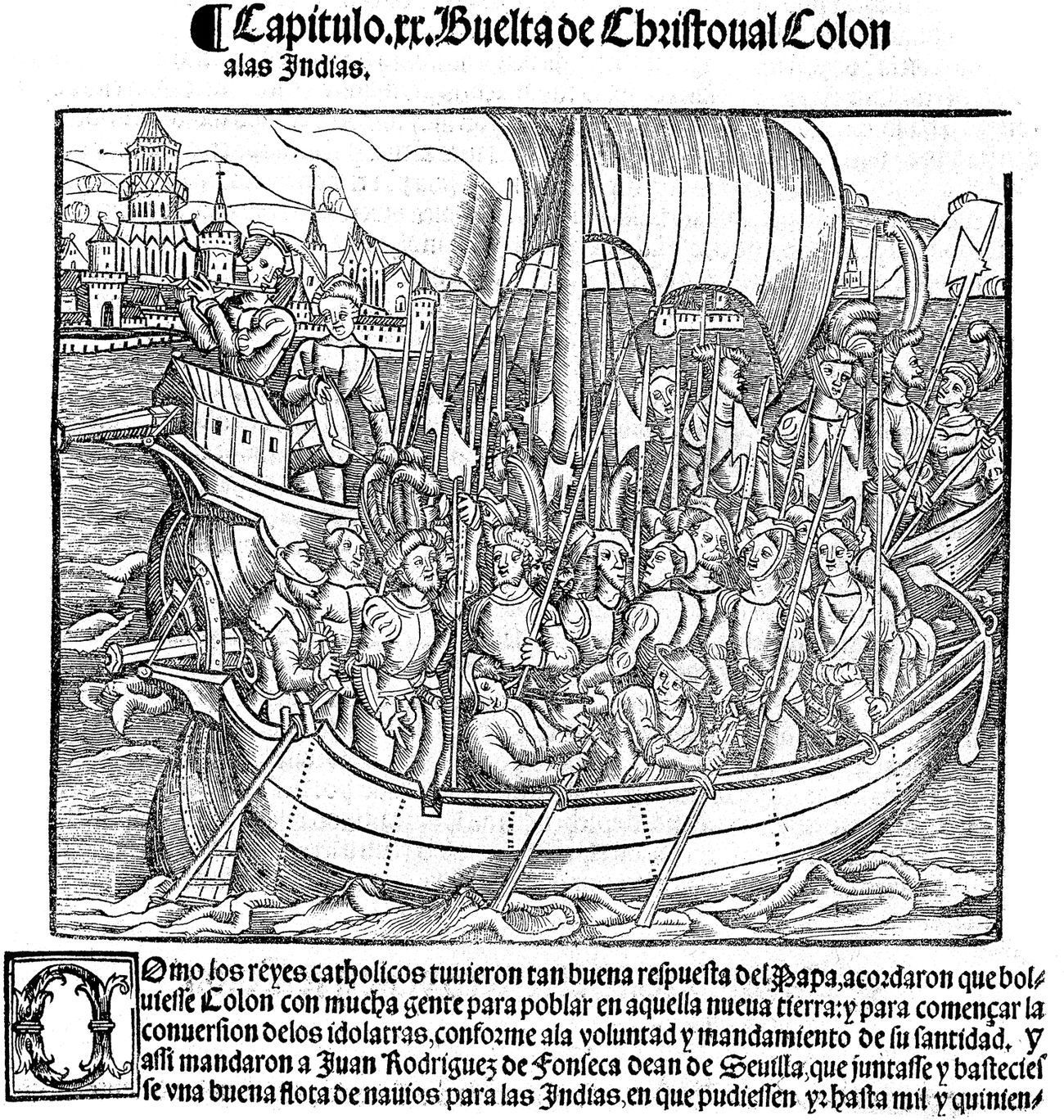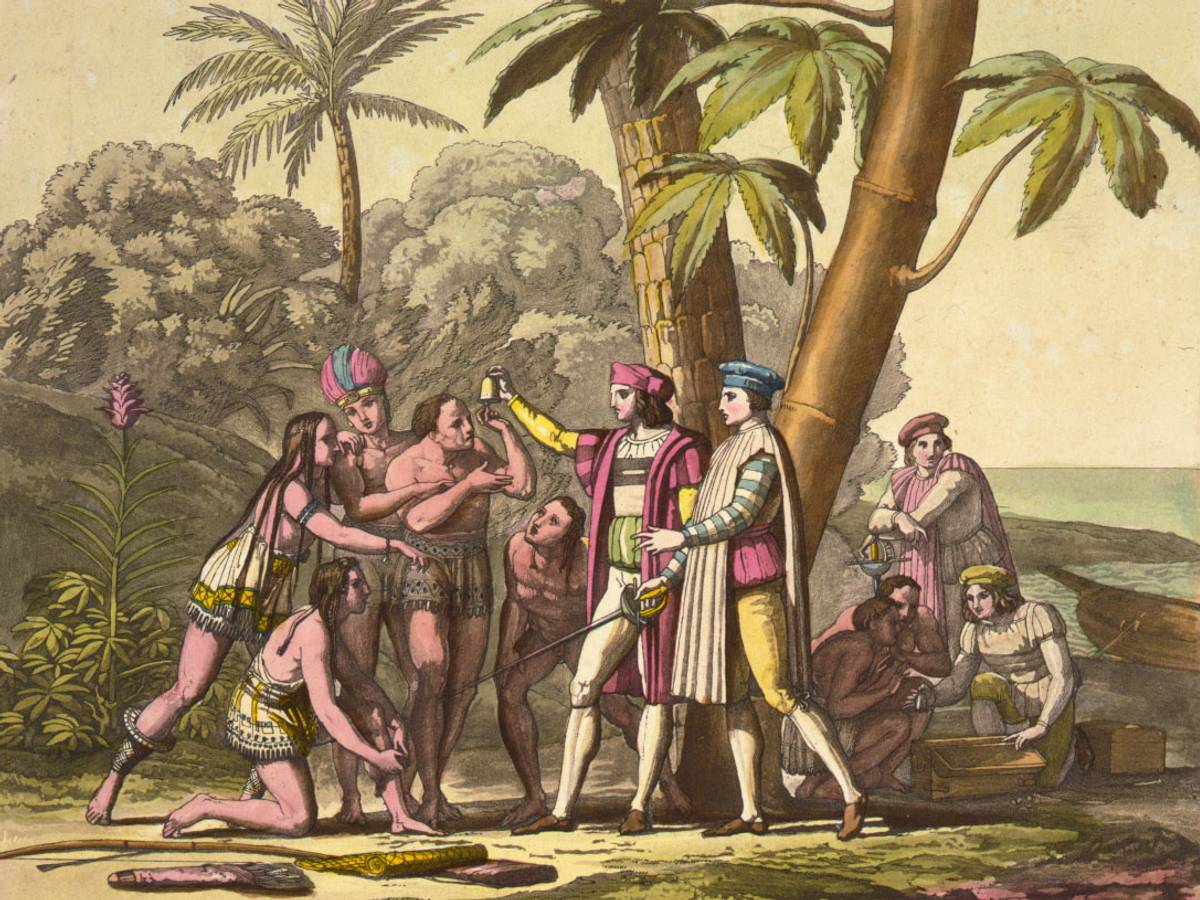The Men Who Gave What Wasn’t Theirs
A translation of colonial Spanish history into biblical Hebrew shows the trauma of 1492 through Jewish eyes




Joseph Ha-Kohen (1496-1578), the historian and (like most other Hebrew men of letters in the Middle Ages), physician, is best known for his chronicle of persecutions of the Jews, Emek Ha-Bakha (Vale of Tears). He was born in Avignon, France, to parents who had fled the expulsion in Spain four years earlier, but grew up, studied, worked, and died in Italy. He knew Latin, was well-read, and had a vast knowledge of geography. In the following text he takes The Book of the New India (1553), a work by a contemporary Spanish writer, Francisco Lopez de Gomara, and translates it—more accurately, he translates, abridges, and occasionally even adds to it—so that his fellow Jews would gain knowledge of the recent discoveries of the New World.
Ha-Kohen uses biblical Hebrew and many easily recognizable classical expressions. When he mentions Queen Isabella, her name is preceded by the word “ha-arurah,” the accursed. He doesn’t hesitate to transliterate a Spanish word when he lacks the Hebrew equivalent, as for instance, “papagaya” (parrots), “gallipavos” (turkeys), and “maize.” For Ha-Kohen, the year 1492 obviously has a greater resonance than for a Christian Spanish historian, so he both cites 1492 as the year of the Jewish expulsion and offers some details about the event, including the lands to which the Jews sailed. Moreover, he expresses tender emotions about this trauma in the recent past, which affected his parents and many still-living Jews when he wrote the book. As a Jewish writer, Ha-Kohen omits “Jesucristo” when it appears in the Spanish, as well as all references to “los reyes catolicos,” the Catholic kings, calling them only “monarchs.” “rulers,” or just “kings.” In dealing with Gomara’s lengthy account of the pope’s proclamation that all the new lands discovered will belong to the kings of Spain, Ha-Kohen reduces it to only a few lines and sarcastically adds to the chapter title the sly phrase, “giving what wasn’t his.”
Ha-Kohen not only translates but also transforms The Book of the New India. Like many Jewish translators of foreign texts, his changes and omissions de-Christianize the text while his Hebrew additions Judaize it. Beyond the immediacy of the reporting in Ha-Kohen’s version, the beneficent and homey scrim of Hebrew gives the reader the sense that Columbus is one of our own. (The issue of whether or not Columbus was of Jewish descent is another matter. But interestingly, the Encyclopedia Judaica, in its article on Columbus, does not place a tiny little “o” to the left of the entry name as it does for citations of non-Jews.)
The chapters below are taken from Moshe Lazar’s transcription of Ha-Kohen’s manuscript in a Paris library, as it appears in his book, Sefer Ha-India Ha-hadasha ve-Sefer Fernando Cortes. Lazar’s edition marks the first time that Ha-Kohen’s version of Gomara’s history has been published, some 450 years after its composition in 1568. And this is the first time that these chapters from Ha-Kohen’s history have been translated into English. I have also consulted Gomara’s original Historia General de las Indias to compare it with Ha-Kohen’s edition and to assess the extent of his abridgment and conflation of chapters. Following are a few pertinent chapters from this history, most of which relate to Columbus. —Curt Leviant
Christopher Columbus [in Hebrew it reads: Cristopha Colonbo; and in Gomara’s history, Cristobal Colon] the Genoan, a man of valor who had sailed the seas all his life, had learned how to make sea charts. He went to Portugal to study the coastal cities of southern Africa and learn how the Portuguese sail to Calcutta.
At that time, a Spanish ship sailed for the Canary Islands, but a wind came and blew her toward a land that neither they nor their fathers had known of and most of the sailors perished during the voyage.
Some time later the ship returned, and on it were some five sailors and the captain. He went to Columbus’ house, fell ill, and died. And until this day no one knows who he was. Only the diary of their route remained with Columbus. From that day on Columbus longed to undertake this very same voyage. So he sent his brother, Bartholomew, to King Henry VII, the King of England, and he requested assistance to go there. He told the king about the great wealth to be found there. But the king paid him no heed. He then made the same request of the King of Portugal, who considered him a jester.
Then Bartholomew went to Ferdinand, the King of Spain, and his wife, the accursed Isabella, during the Battle of Granada, in 1486. But at that time they refused to listen. However, after talking to them day after day, they began to believe his promises that he would bring them great riches, silver and gold and spices. They then honored him [him being Columbus; probably because Ha-Kohen has combined several chapters into one, he erred in his use of names] and he found favor in the eyes of all who saw him.
The monarchs offered him 10% of the taxes he would impose on the lands that did not belong to the King of Portugal, for there was peace between Portugal and Spain. And they made a compact with him, signed and sealed in Granada on the 30th of April in 1492, the year of the expulsion.
In that awful year, all the hosts of the Lord left Spain, upon the command of these monarchs, during the fifth month [Av, counting Nissan as the first]. And from there they spread to the four corners of the earth. They went by ship to Africa and Asia, to Greece and Turkey, where they reside to this very day. On a Friday, the 10th of the month [i.e., one day after Tisha B’Av, the date of the expulsion] 16 great ships, filled with many people, departed from Cartagena. And what did they do in the rest of the king’s cities and coastal towns? They fell victim to many misfortunes and grievous tribulations that afflicted them on their way. Look, O Lord, and see—save us for your Name’s sake.
These two monarchs gave Columbus three ships. He set sail with his brother, Bartholomew, along with about 150 men, starting their voyage from Palos de Moguer, on the 3rd of August, sailed past Gomera, one of the Canary Islands, and continued westward. One day they found a plenitude of seaweed on the surface of the water, which frightened them greatly. But they continued on their way and did not stray from it.
One day one of Columbus’ men saw a fire from afar and reported it to his fellow sailors. Hearing this, their spirits revived.
The next morning, the 11th of October, the lookout gave a great shout:
“Land! Land!”

They all ran to see and rendered thanks to God; they raised their voices and wept. And the men kissed Columbus’ hands, exclaiming as they bowed down to him:
“We are your slaves.”
They drew near to land and came to the island of Guanahani, part of the Lucayos Islands, which lie between Florida and the island of Cuba, the first island that was conquered on behalf of the Spanish monarchs.
From there they set out for Barucoa, on the island of Cuba, where they took some local men. Then they turned back to the island of Haiti, where they dropped anchors and encamped. Columbus called that place Puerto Real and there one of his ships was severely damaged. The men then made for land and Columbus joined them at that time.
Seeing the Spaniards and their weapons, the Indians assumed they were cannibals and fled to the hills. During their pursuit, the Spaniards encountered a naked woman and gave her bread and wine and a linen shirt and clothes to cover her nakedness. Then they sent her away and she ran and told the Indians what the Spaniards had done for her.
Many of the Indians then came back to the coast, but since no one could understand the other person’s language, the Spaniards spoke with them as one speaks to a mute. The natives brought them bread and fruit, fowl and gold and many things, and they traded with the Spaniards for bells and glass necklaces and needles and many other things they had in their possession. Columbus was very pleased. And then came Guacanajari, the chief of the city, whom everyone called Cacique [chief], and they greeted each other and exchanged gifts and made a peace pact.
The Indians brought thither some of their boats to remove the contents of the wrecked Spanish ship. They did this with heartfelt devotion and were of great assistance. Columbus was very happy to see how much gold they had and that they were on good terms with them. He made plans for returning and telling the monarchs what they had found there. He built a fortress with the permission of Cacique, whose men helped until it was completed.
Columbus assigned 38 men to remain there to learn the natives’ language and their secret pathways until he returned. He took 10 Indians with him, 40 parrots, many turkeys and conies, peppers, batatas, and maize, and other things that they had never seen before, as well as the gold for which they had bartered. Columbus then set sail. The chief, Cacique, wept as they departed from his city.
Fifty days later, in 1493, Columbus returned to Palos de Moguer.
When they disembarked huge throngs came to see Columbus and his men and the natives they had brought back. These Indians astounded many onlookers. On April 3, Columbus went to Barcelona where the monarchs were at that time. They honored him greatly and he bowed low before them. He presented them with the gold and all else he had brought from that new world on which no man had ever set foot before. They were amazed at the splendor of the parrots that Columbus had brought and also by the Indians, for they wore gold earrings and had gold rings in their noses.
A sight like that had never before been seen in Spain. But only six Indians survived the voyage because their comrades had died en route, for they had lost their will to live.
The two rulers and their firstborn son, Don Juan, baptized these Indians, considering this act a sin offering. They were also astonished to learn that the natives of these lands go about naked, were illiterate, had no money, iron, wheat, or wine, and possessed no horses, donkeys, or beasts of the field.
The kings also marveled that these people possessed no large ships but used canoes that were fashioned like a box from one piece of wood, and that neither mallet nor axe was heard as they were being made. They were also appalled to hear that the natives ate human flesh as others ate deer and rams, and that they worshipped idols.
And they swore that they would rid that land of all these abominations that had been passed down to them by their ancestors. The two rulers honored Columbus, who sat on a chair before them—something that had never before been done in Spain unto this day. And they made a compact with him, similar to the earlier one, and appointed Columbus the chief naval officer of the Indian Sea, designating him an Admiral of the Ocean Seas; at the same time they also appointed his brother, Bartholomew, a Royal Representative.
Columbus wrote on his shield that he henceforth kept in his possession:
“For Castilla and for Leon;
A new world found Colon.”
[Ha-Kohen did not translate the above couplet into Hebrew but wrote it in Spanish with Hebrew letters, for he wanted to preserve the exact wording on Columbus’ shield. The following Spanish words come from Gomara’s text:
por Castilla y por Leon
nueva terra hallo Colon.
But it is interesting to note that in Ha-Kohen’s manuscript the couplet reads:
Por Castilla y por Leon
Medio mundo hallo Colon
For Castilla and for Leon
Half a world found Colon.]
Even though the masses called these lands India, it is a borrowed name, for the real India is the place to which Alexander Macedon [i.e., Alexander the Great] traveled, and it is called India for the river Indus that runs through that entire region. From that land many people have come. As we read in Herodotus’ History, they settled in Ethiopia, which is between the Red Sea and the Nile. They increased and grew in strength and they named that place India too, by which name it is known to this very day.
The Spanish rulers wrote about all these matters to the Great Priest, which gladdened all the other priests greatly. The pope then gave the Spanish monarchs all the islands of the Western Sea and everything they would discover in the West, as long as they would take the natives of those lands out of the darkness, cloud, and fog in which they had been nurtured by their forefathers.
Columbus had become very arrogant. And so Rolando Jimenez along with about 70 men left him and went to Jaragua, where they stayed a long time. Columbus summoned him but Jimenez did not heed him. So Columbus wrote a disparaging letter about him to the monarchs, and the land was in a tumult because of his words. Rolando and his men, enraged at Columbus and Bartholomew, wrote to the rulers about Columbus, slandering him and his brother and spreading evil reports about them. The monarchs then sent Francisco de Bobadilla to be overseer of all those new lands [superseding Columbus].
In 1499, they sailed in four ships to the Spanish island [Hispaniola; today Haiti and the Dominican Republic]. They seized Columbus and his brother and sent them to Spain in chains. When they were in Cadiz the king commanded them to be set free and they appeared before him. Columbus spoke to the two rulers and wept. They heard him out, but when they declared he would no longer govern those new lands, Columbus’ face fell.
(Columbus’ fourth voyage, in 1502, began with four ships, but two of them crashed into rocks and were wrecked near Jamaica. His sailors fell ill, natives stole the provisions, and a mutiny among the sailors ensued. The Indians, seeing the problems Columbus was having, refused to sell him food and planned to attack the Spaniards. Then Columbus tried to appeal to them.)
“Give us food for which we will pay generously. Why should we die of hunger? However, if you refuse, be warned that you will surely die in the plague and not a soul of you will be left alive. And here is the sign: One day soon the moon will turn to blood.”
For Columbus knew that a lunar eclipse would occur. And when the natives saw that there was no moon on the day that Columbus had predicted and that darkness covered it, they believed Columbus and were terrified of him.
The Indians wept before him and pleaded with him, saying:
“Please forgive us our sins and the wrongs we have stupidly committed.”
They then brought Columbus everything he had requested, in order that he pray to the moon on account of their sins. The sick men in Columbus’ ships recovered their strength and obeyed him henceforth.
The Spaniards settled and spread over the land and regularly wrote letters to one another. The Indians said: They are angels of God. They are able to speak to each other, even though great distances separate them.
Note the following incident:
Once, a Spaniard sent his Indian servant with a letter and 12 cooked conies to his friend. On the way the Indian grew hungry, ate three of the conies, and delivered the rest to his master’s friend. The recipient sent a letter back with the Indian, saying, “I have received the nine conies you sent me, for which I thank you very much.” When the native returned to his master, he scolded him. The Indian was astounded and wondered who told him. And then he realized that the writing had revealed his secret and he confessed his sin. Outside, he told his comrades, “Beware, for that writing reveals everything.”
Curt Leviant has translated four volumes of Chaim Grade’s fiction, including his two-volume The Yeshiva. He is also the author of 14 novels, the most recent of which are the just-published Tinocchia, the Adventures of a Jewish Puppetta and The Woman Who Looked Like Sophia L.